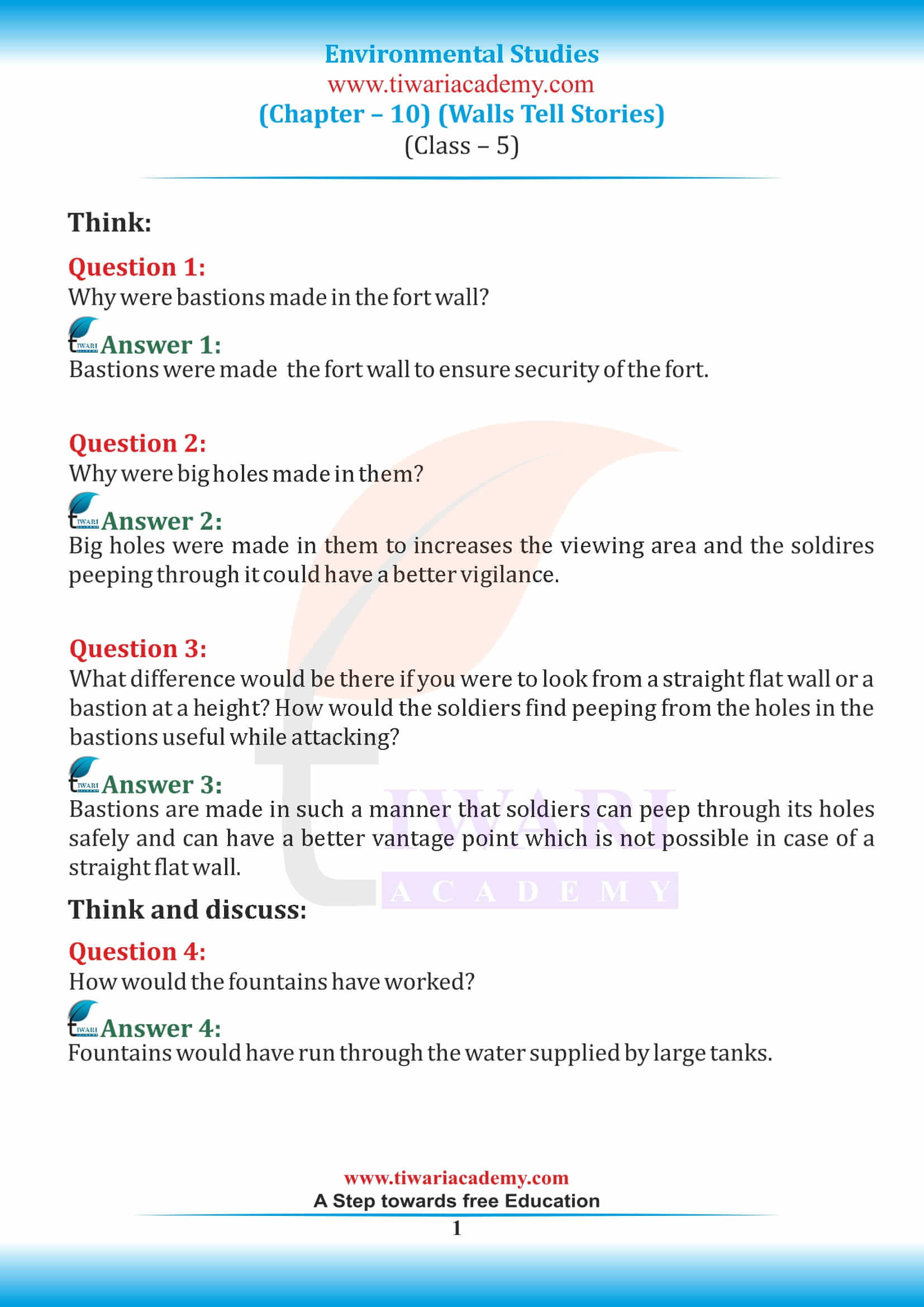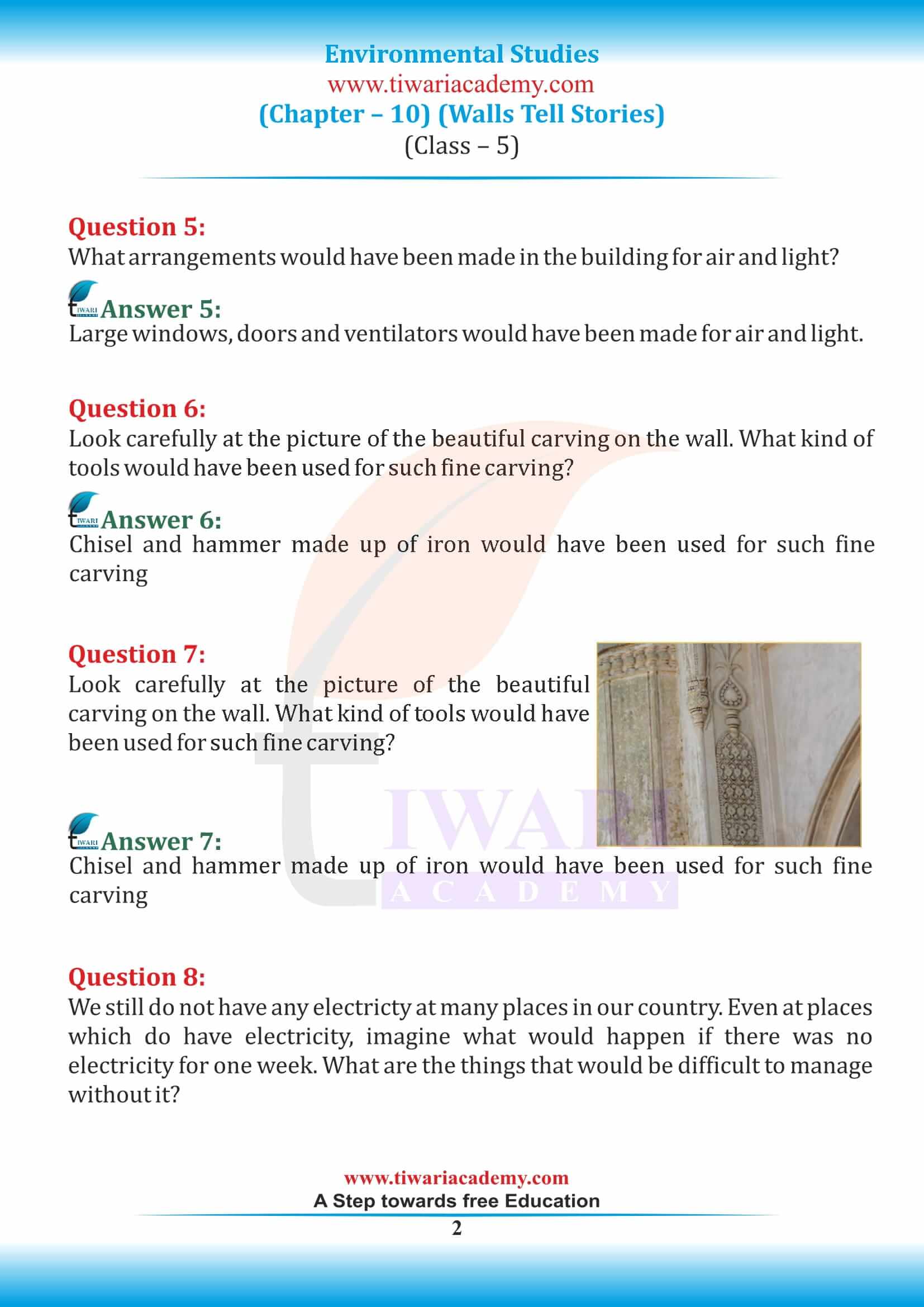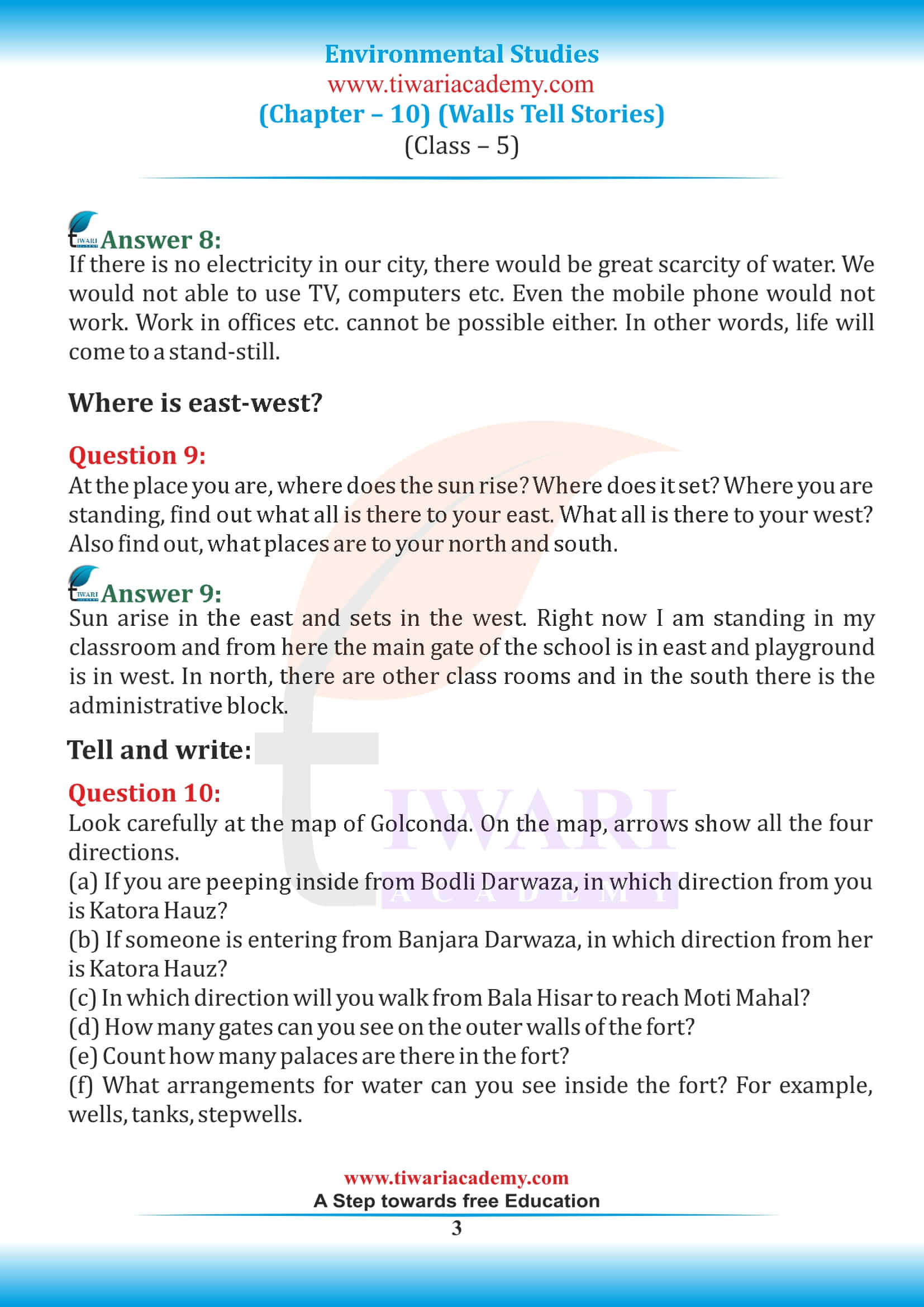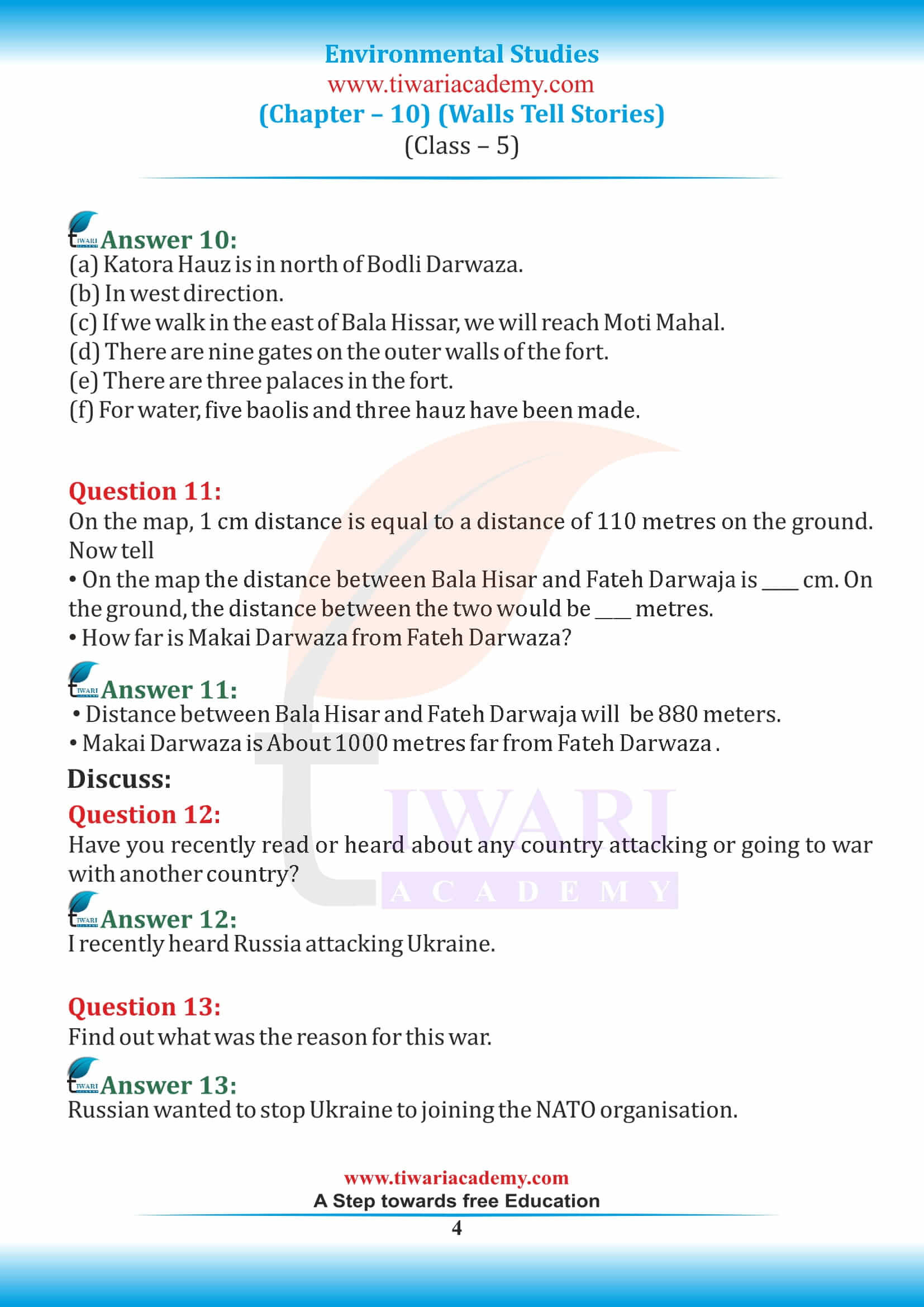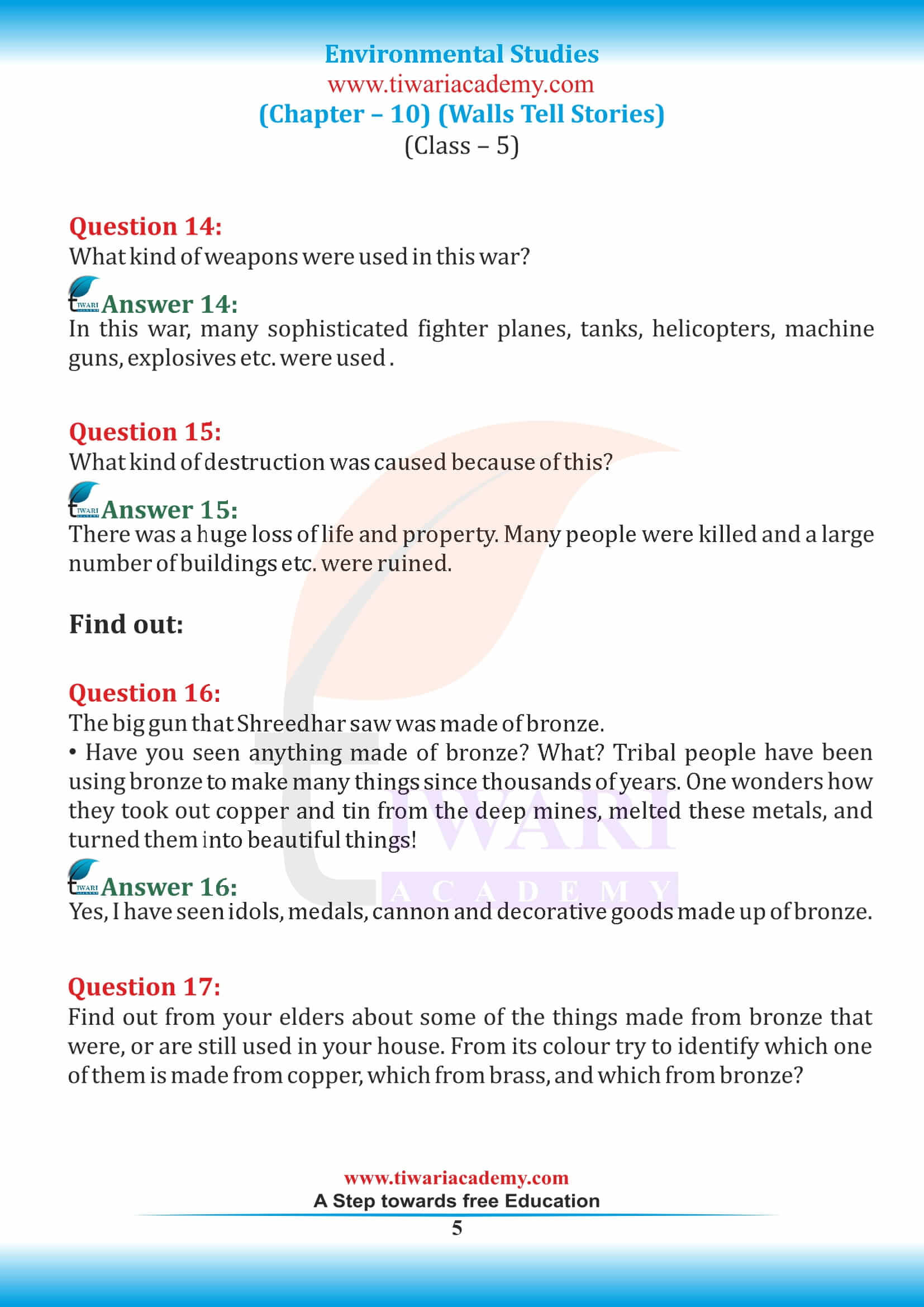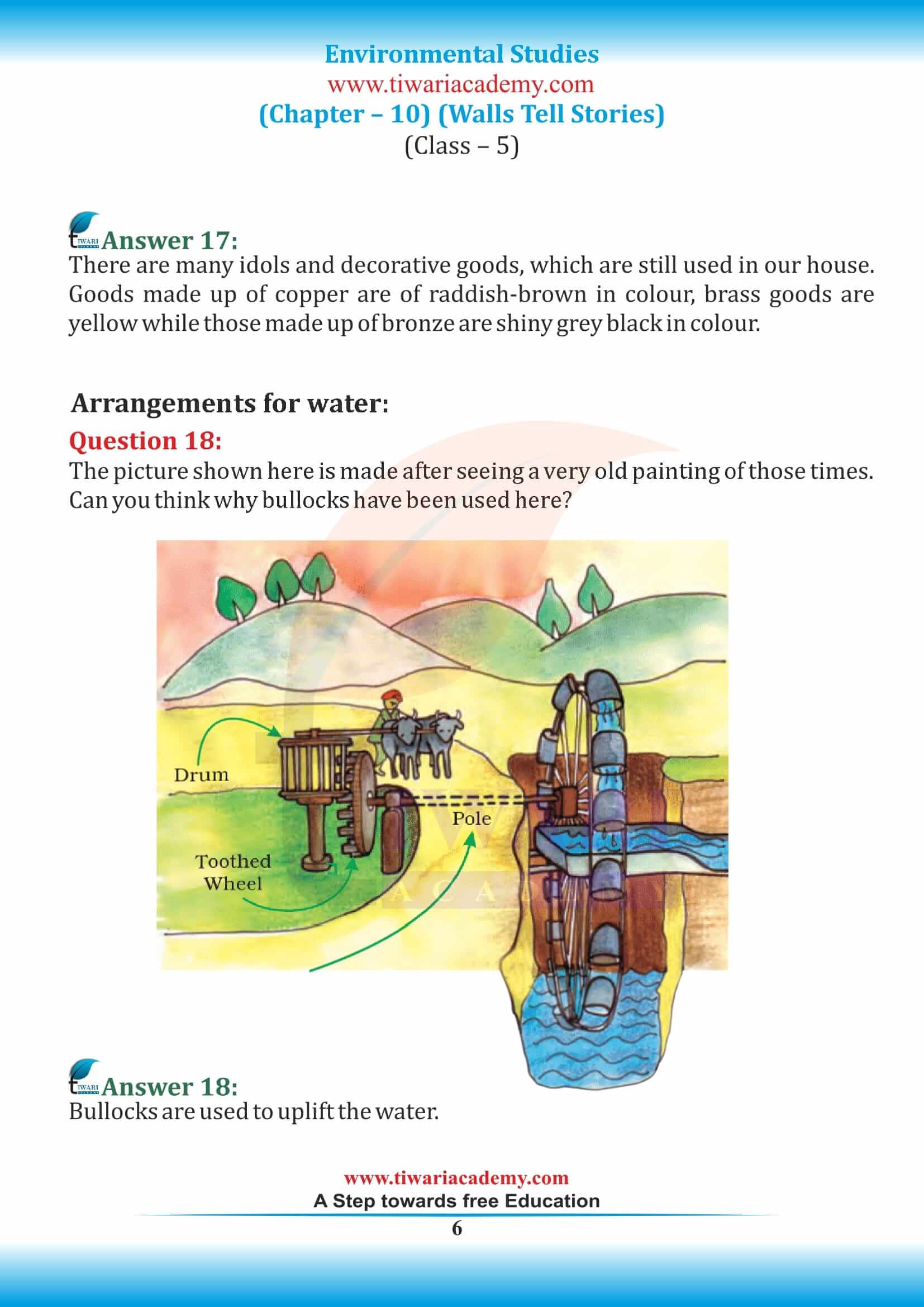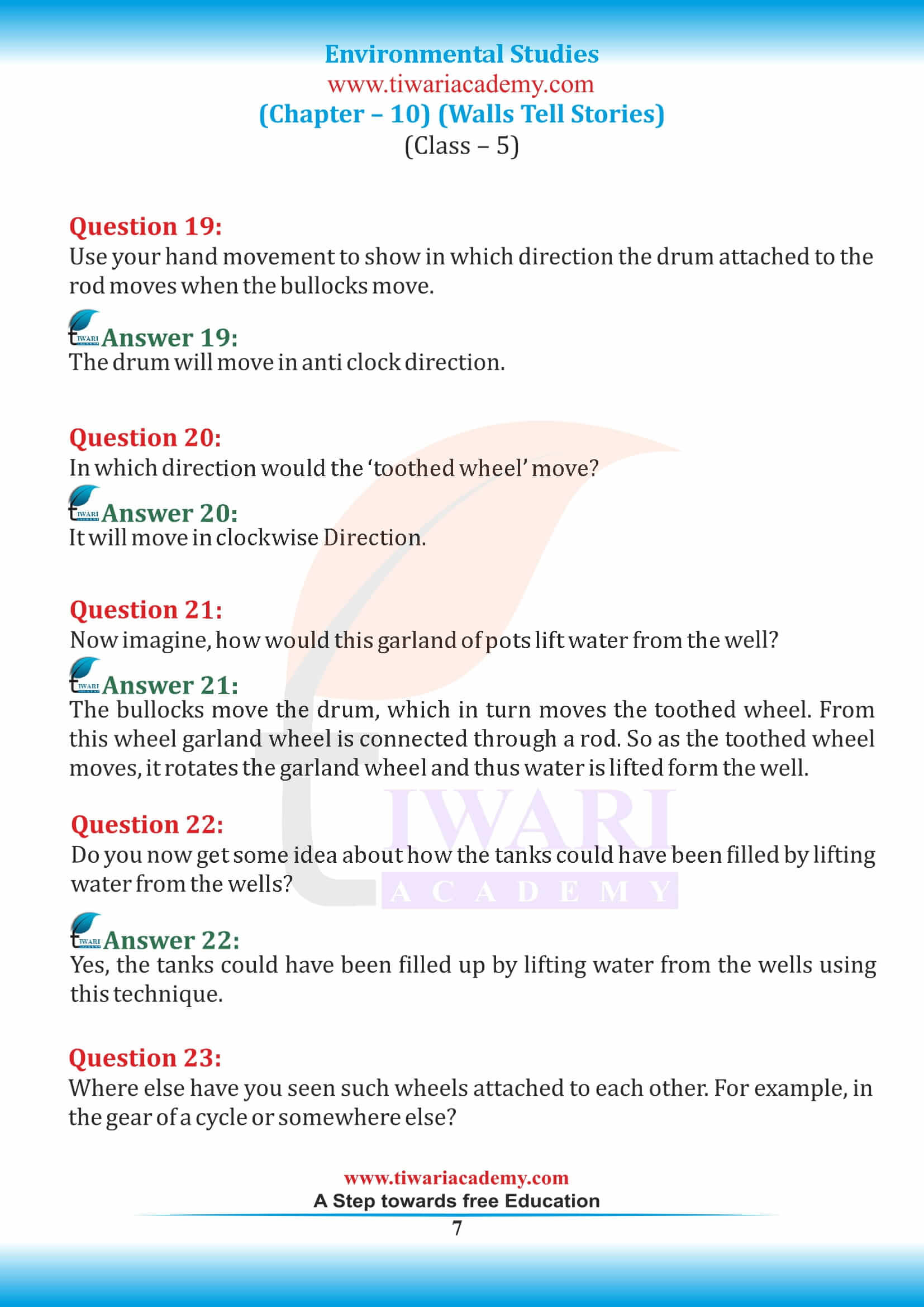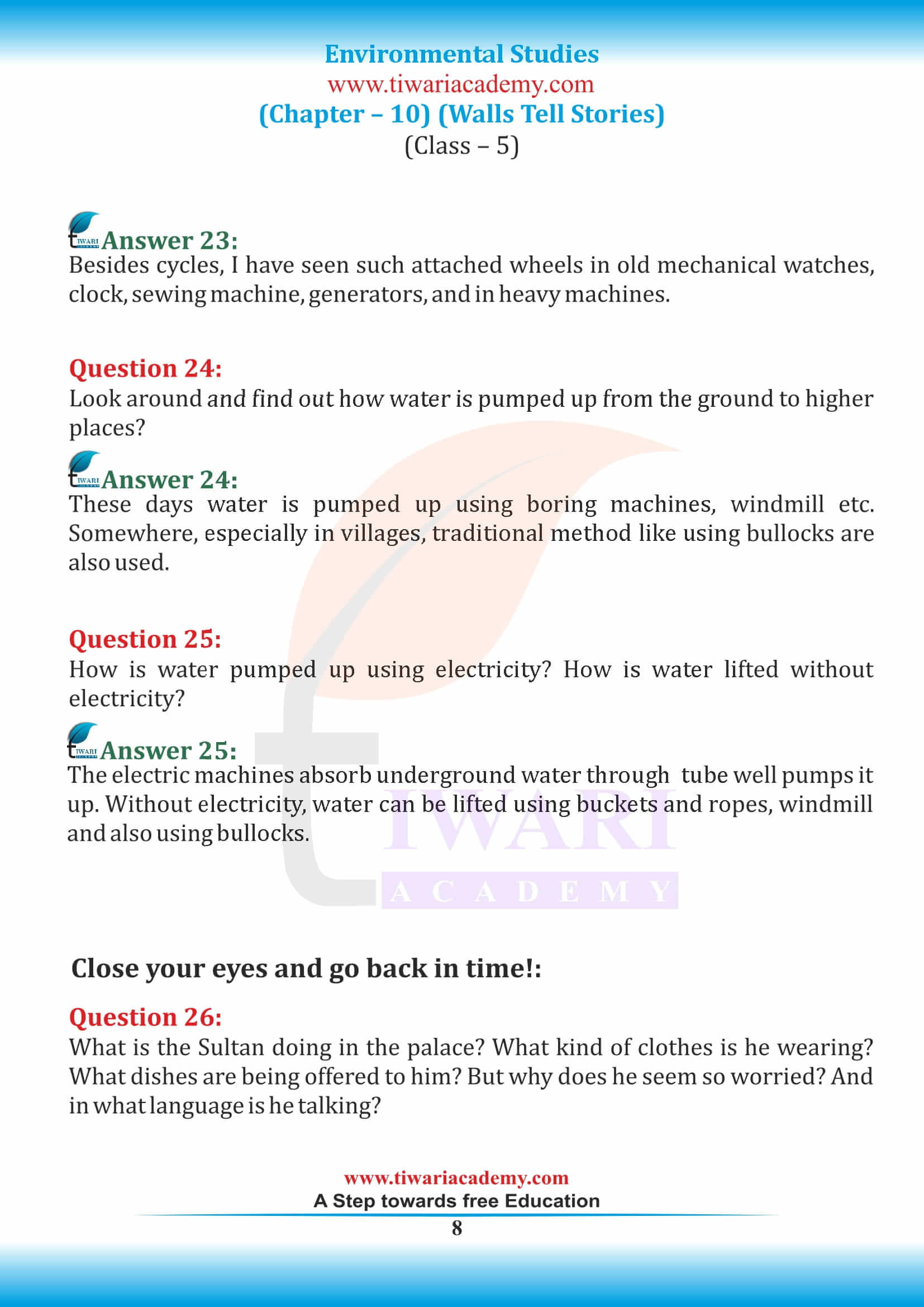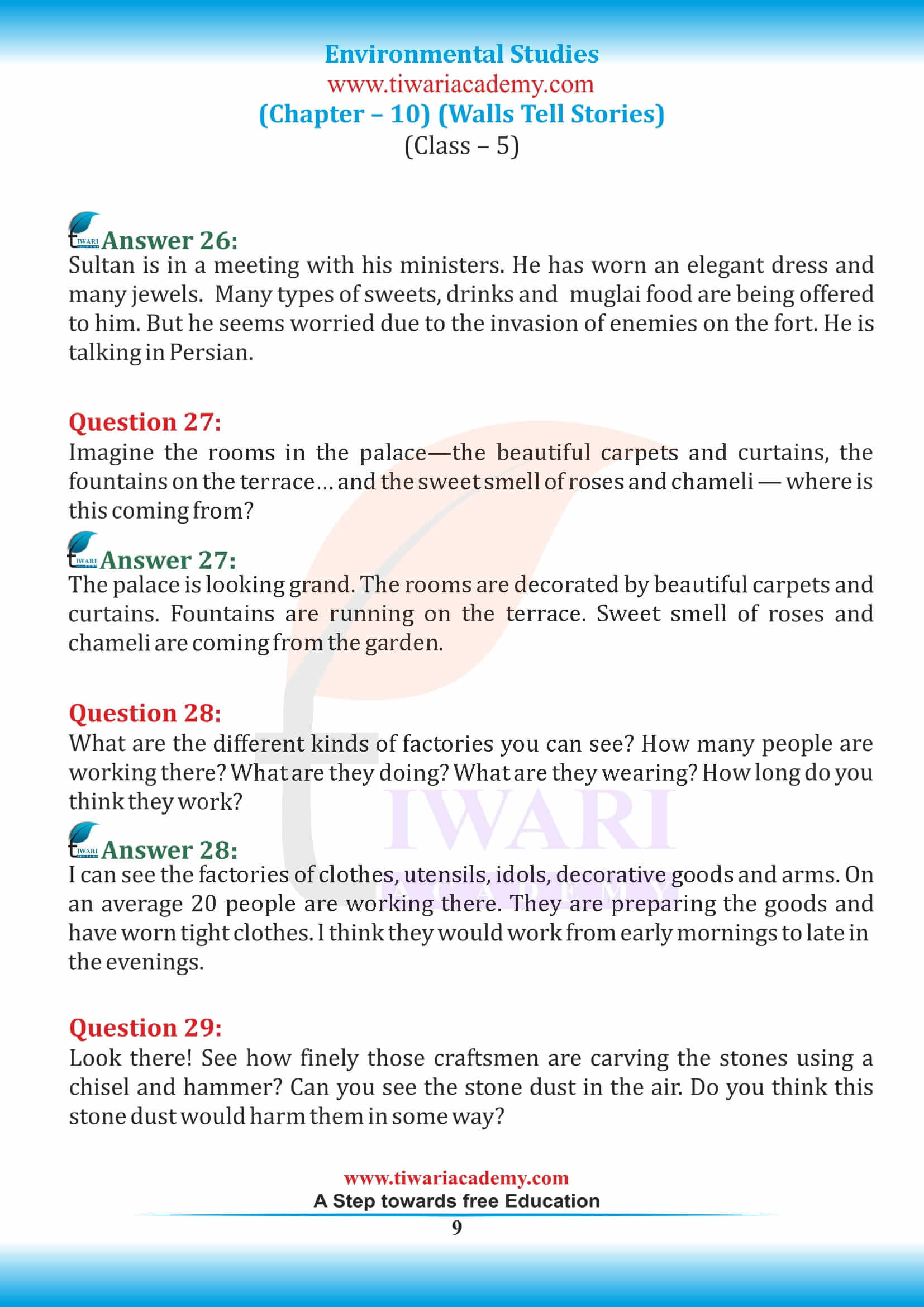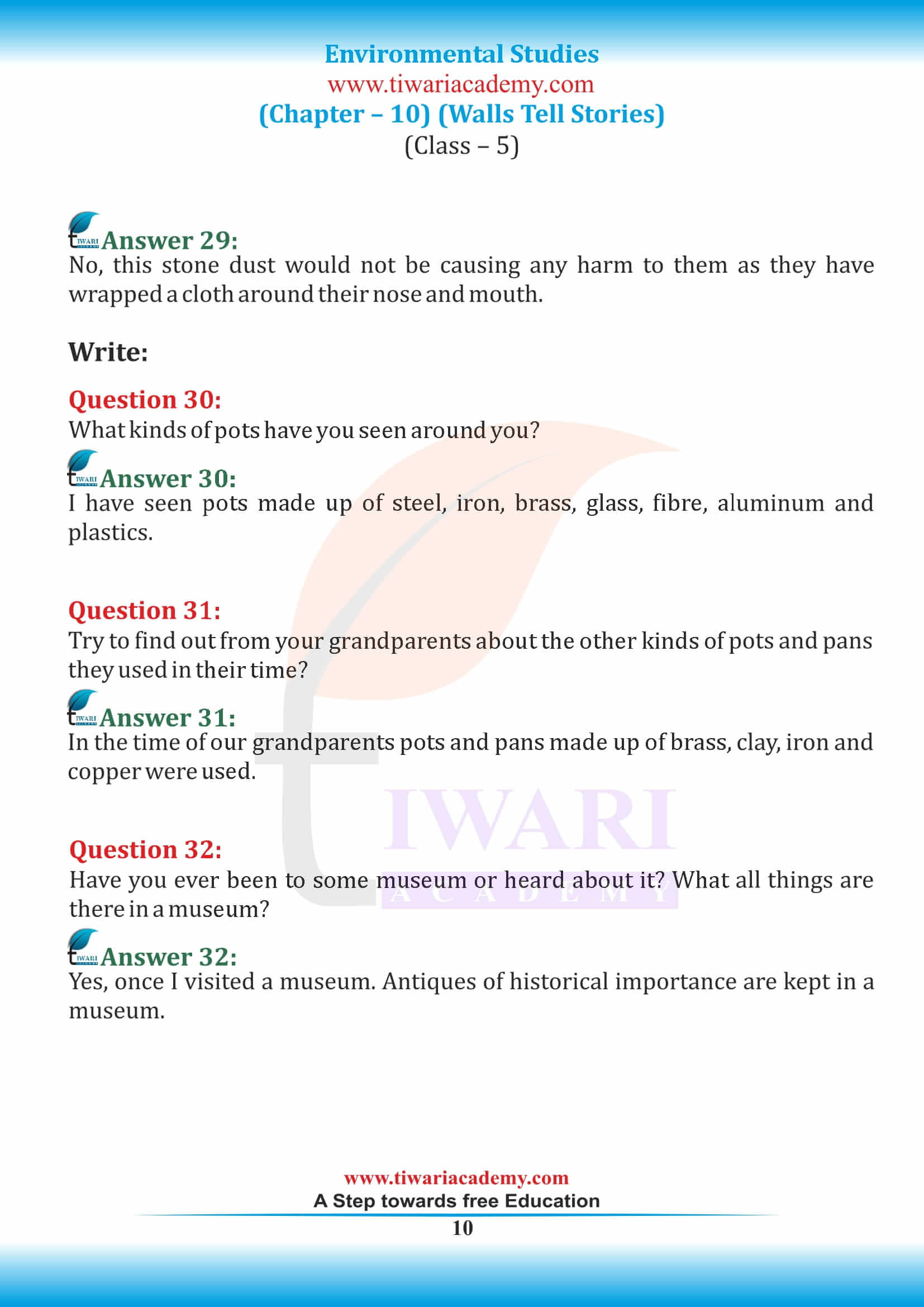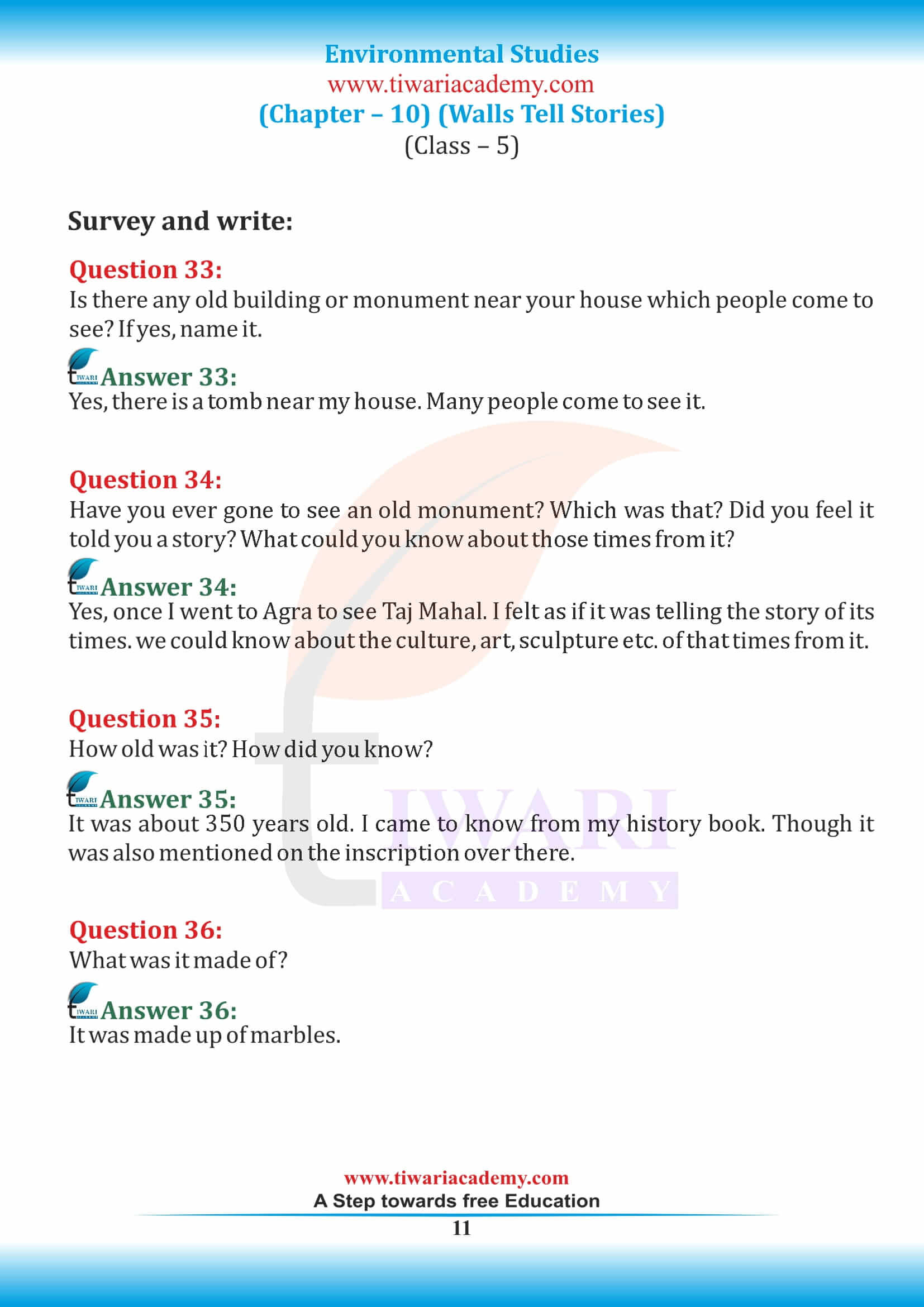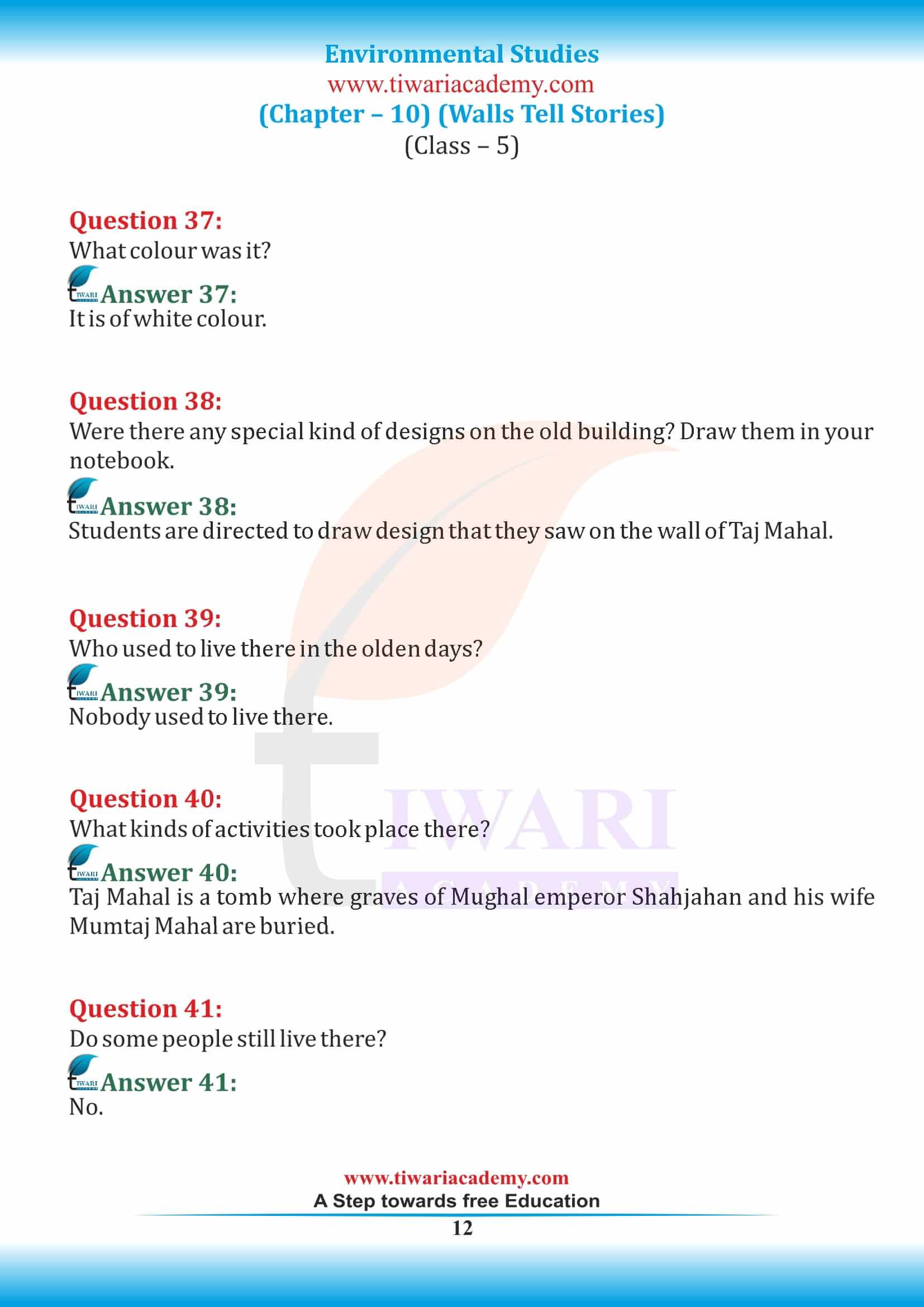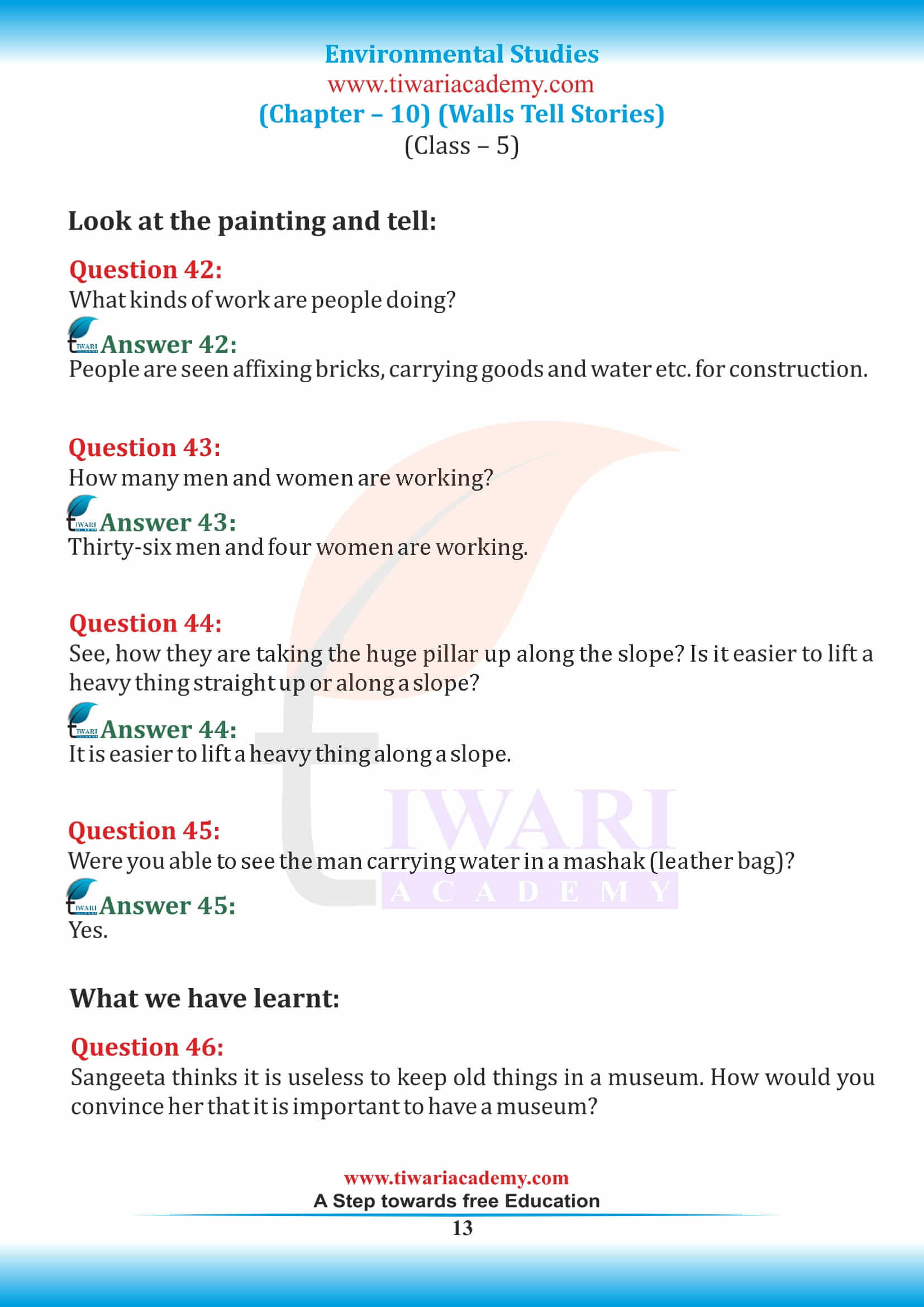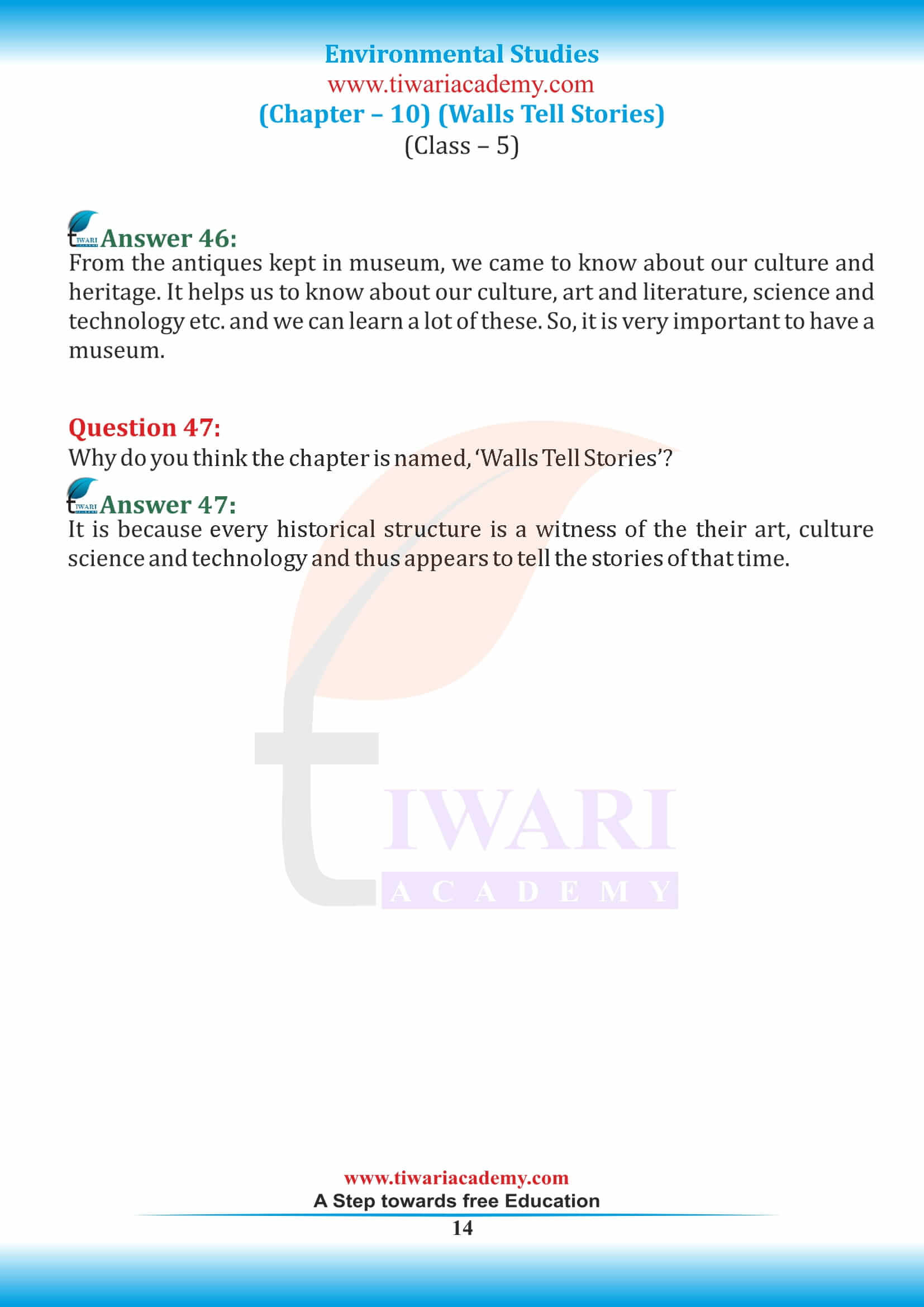NCERT Solutions for Class 5 EVS Chapter 10 Walls Tell Stories in Hindi and English Medium Question Answers with complete explanation updated for new academic session 2024-25. All the solutions as well as study material related to class 5 Environmental Studies are free to use without any login or registration. We have included extra question answers also which are quite important for class test or term 1 and 2 exams.
NCERT Solutions for Class 5 EVS Chapter 10
Class 5 EVS Chapter 10 Question Answers Walls Tell Stories
Class 5 EVS Chapter 10 Question Answers Set 1
What is History?
History is the study of events that happened in the past. It is the study of change which took place over time, and covers all the aspects of human society. Political, social, economic, scientific, technological, medical, cultural, intellectual, religious and military developments are all part of history.
Where is Golconda Fort situated?
Golconda Fort is located in the western part of Hyderabad and is about 9 km from the Hussain Sagar Lake. The outer fort of the main fort occupies an area of three square kilometers. It was also called Mankal, and built on a hilltop in the year 1143.
What are bastions? How many bastions are there in Golconda fort?
Bastions are intentionally constructed platforms on which cannons were placed. The outer wall of the Fort consists of 87 bastions. In front of the burj, a small protective wall was also built-in order to prevent the artillery shells from hitting the soldiers themselves or the cannons placed above it.
Which emperor’s cannon is kept in Golconda fort?
Emperor Aurangzeb cannon is kept in the Golconda Fort.
Question:
Why were bastions built in fort walls?
Answer:
Bastions were built in fort walls as-
- they safeguard the fort from enemies.
- Big holes were made in the bastions to see at a distance and attack enemies coming towards the fort from several directions.
- Bastions are built at a height to provide space to look on distant places from several directions.
That is why bastions were even higher than the fort walls.
Class 5 EVS Chapter 10 Question Answers Set 2
Why was Aurangzeb’s army unable to get into the Golconda fort?
It was difficult for the Aurangzeb’s army to attack the fort because of the strong thick walls along with a long deep ditch which made it difficult for him to conquer it. The army camped for about 8 months and was successful in conquering the Deccan in 1687.
Why were big holes made in the bastions?
Big holes were made in the bastions to-
• watch and shoot the enemies from a distance,
• keep the soldiers safe.
• attack the enemy without being seen also to increase the viewing area.
How did the emperors and kings make smaller kingdoms a part of their own kingdom?
Emperors usually adopted two strategies to make the smaller kingdoms a part of their own kingdom.
• Tactical marriages: In this the emperor would marry the daughters of the neighbouring kings and make their kingdom a part of their own empire, while allowing the existing king to continue ruling as a vassal
• Defeating the smaller kingdoms in battle was another way of making smaller kingdoms their part. After the defeat, the emperor could either include the neighbouring kingdom into their empire and rule directly over it, or he could allow the king of that kingdom to continue ruling but by paying a tribute to the emperor and acknowledging the emperor’s power.
How was the water lifted to big tanks and fountains on the roof?
The bullocks were made to move the drum, which in turn moved the toothed wheel. So, when the toothed wheel moved, it rotated the garland wheel and thus water was lifted form the well.
What were the arrangements of light and air in Golconda fort?
The arrangement of light and air in the Golconda Fort was that there were large windows, doors and ventilators which had been made in the building for air and light.
Which things were found when the place around Golconda was dug?
The things which had been found in the places around Golconda were the pots, jewellery, swords, etc. and curtains, the fountains on the terrace.
Question:
Describe the architecture of the Golconda fort.
Answer:
The architecture of the Fort is as follows:
- Golconda Fort had eight gates out of which the main gate was the Fateh Darwaza or the Victory Gate.
- The length of the gate is 25ft and width is 13ft.
- Bala Hissar Gate is the main entrance to the fort located on the eastern side with the design of peacocks and lions.
- The gate is quite magnificent and was used to inform the residents of the fort about any kind of danger.
- It actually consists of four forts with 10 km outer wall and 87 semi-circular bastions known for its magical audio system.
- It has beautiful carvings on the wall and a fountain on the terrace.
- The fort has 720 steps and the outer wall of this fort has 87 bastions.
Question:
It is important to have museum. Give reasons why?
Answer:
A museum is a place that conserves or looks after for a collection of artifacts and other objects which are of artistic, cultural, historical, or scientific importance. It is important to have museum because the museums:
• not only collects but also preserves our objects and materials of religious, cultural and historical value.
• are a good source of entertainment.
• help to preserve and promote our cultural heritage.
• are a storehouse of old artefacts, sculptures, objects, history etc.
• is a source of income as people come and visit it to gather information about various things, especially tourists.
• are also important as school students also visit it to gather more information and knowledge about the past or scientific importance.
Class 5 EVS Chapter 10 Question Answers Set 3
How do the people come to know our past?
There are various sources which help us to know the past of our country like-
• sources (like books, newspapers, and letters)
• artifacts (like pottery, tools, and human or animal remains.)
• Libraries, archives, and museums also collect and keep these things for people to study history.
What is a cannon?
A cannon is a large, heavy gun which is generally mounted on a carriage. It is used mainly as anti-infantry weapons around 1374, when large cannons had broken the walls during wars.
Why were their sharp iron spokes on the gate?
The gate was made of thick wood into which long iron spikes had been fixed. The spikes were so sharp on the end so that not even an elephant could not push the gate open. Even if an elephant tried to open the gate, the iron spikes would go right into its face and hurt it. The gate also had two giant doors that opened in the centre. This had been done for safety purpose too and the elephants of the enemy would hurt themselves if they tried to open the gate by bumping their heads on it.
What is the use of toothed wheel?
A toothed wheel a wheel which has teeth or projections on its edge or circumference, to cut or set for transmitting motion by their action on the engaging teeth of another wheel. A bullock is used to move the toothed wheel. As the bullocks move the drum, the toothed wheel connected to it also moves, which in turn rotates the garland of pots which lifts water from the well.
Why is deep ditch dug along the walls of the fort?
The purpose of digging a deep ditch along the walls of the fort was to stop the entry of the enemies from reaching the top of the walls by using ladders. Thus, the enemy could not cross it easily and failed to enter the fort.
Question:
Name the things that ensured the security of the fort.
Answer:
The things which were made to ensure the security of the fort are:
• Watchtowers which were made inside ensured the protection of the fort in a higher place with the purpose to watch over the surrounding areas.
• The Bastions were made in the front wall to ensure the security of the fort. Bastions were built with big holes for the soldiers to watch over the area by peeping through it without getting hurt.
• Digging of deep ditch to ensure that the enemy could not enter the fort.
• Making a small gate inside a big gate.
Class 5 EVS Chapter 10 Question Answers Set 4
What was the purpose of making a small gate made in a big gate?
The purpose of making a small gate, called the needle’s eye, was to ensure the safety of the fort. Because of that small gate only one person could enter inside at a time so this also ensured the safety of the fort.
How is water pumped up using electricity? How is water lifted without electricity?
The water is pumped up using electricity with the help of the electric machine which absorbs underground water through tube well and pumps it up. Ans water is lifter without electricity, by using buckets and ropes. windmill and also using bullocks.
What is a mehrab?
A mehrab is a semi-circular position or an arch in the wall of a mosque or religious school which the Muslims face when praying. It is the architectural and symbolic central point of religious buildings.
Why do you think the chapter is named Walls tell Stories?
The chapter deals with the historical structures and monuments built in the earlier times. They tell us a lot about the people who lived there, their art, culture, craft, technology they used, architectural styles and events of the historical period. Thus the name ‘Walls Tell Stories’ is apt for this chapter.
Monuments speak a lot about history. How?
Monuments are the old buildings built by great rulers and kings of India or the visitors who came to India, ruled over India and built them like Mughals, British etc. These old and beautiful buildings teach us about our history and what had happened before we were born.They promote the respect for those who lived in different times and different societies and promotes pride of our past and heritage making it unique in the world. It also attracts a large number of tourists to our country.
Class 5 EVS Chapter 10 Question Answers Set 5
How do people spoil the monuments?
People spoil the monuments by:
• scribbling on the walls, by writing their names on the walls or making some figures on the walls
• spitting on the walls of the monuments
• breaking some part of the monument
Why is important to conserve the monuments?
It is important to conserve the monuments because they-
• remind us of our heritage.
• are like a treasure for the nation
• are a symbol of pride for us.
• help us to know about the past, cherish and appreciate our past and
• enable us to know the level of development, knowledge and thoughts.
• provide life to our past.
Enlist the various ways in which we can conserve our monuments?
We can conserve our monuments by-
i. stopping ourselves and others from scribbling on the walls.
ii. participating in the regular Cleanliness Drives to ensure that the monuments remain clean.
iii. becoming a part of the ‘Adopt a Heritage’ initiative wherein we work for conserving the monuments.
iv. spreading awareness amongst the people around about these monuments and their importance.
How did the kings protect themselves from their enemies?
The kings protected themselves from their enemies by:
• Making bastions which safeguarded the fort from enemies.
• Making big holes in the bastions to see at a distance and attack on enemies coming towards the fort from several directions.
• Building bastions at a height to provide space to look on distant places from several directions.
• All this was done to prevent the enemies from attacking the kings.
Who was the sultan of Golconda Fort?
The ruler of Golconda was the Abul Hasan Qutb Shah. Aurangzeb and the Mughal army had successfully conquered two Muslim kingdoms: Nizam shahis of Ahmednagar and the Adil shahis of Bijapur.
Question:
What is carving?
Answer:
A carving is an object or a design that has been cut out of a material such as stone or wood. Carving is the art of carving objects, or of carving designs or writing on objects. It is done on buildings or wooden material. It is thus the cutting of material done to form a figure or design
What does chapter 10 of the EVS 5 class try to teach to the students about the walls?
The chapter is meant to share the history and how we get to know about the information of the people who build and how they build it in the absence of the technology present today. The lights and electricity and made the work easy but these massive structures with the huge bricks and walls have been built with the help of something and when one discovers it they will be amazed to see how the ancestors used their knowledge to make such things hundreds of years ago.
Do you think chapter 10 is about the history in 5th class EVS?
The chapter is indeed sharing the information to the children with the information on how significant the discovery was. As we can see so many buildings are without proper maintenance they might fall down but these walls are still standing and answering all the questions about the people who build it and used to live in and how it been a secure location that could accommodate so many people and still standing tall facing unforgiving nature.
Do you think class 5th EVS chapter 10 from the NCERT book is difficult to understand and needs time to learn?
The chapter is full of important information about the significantly important people in history who influenced the history and culture of India. This is why the chapter requires someone’s guidance to complete and as there might be more questions come from students that might be answered to understand the chapter and then indeed it required the time to learn the chapter.
